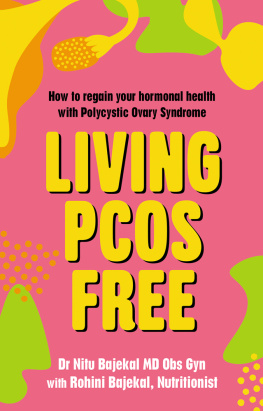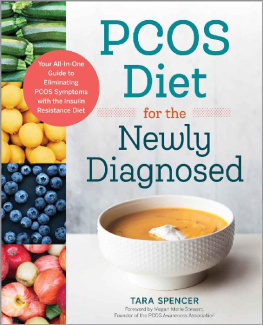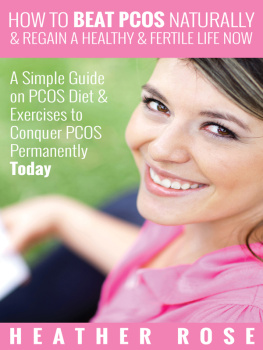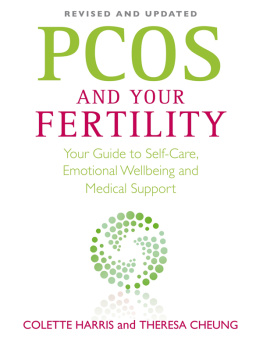FOREWORD
Polycystic ovarian syndromeIts a mouthful to say. The name itself can be confusing to the listener, since it inadequately and misleadingly describes the condition as a seemingly physiological female problem. Even medical professionals often do not understand what it is. When spoken in general conversation, this term elicits a blank stare from most people. Others nod knowingly, as they mistakenly assume this condition is related to development of classic ovarian cysts, a common but usually unrelated gynecological condition.
What most do not know is that PCOS is an important endocrine condition, affecting many hormones throughout a womans body, and impacting multiple organ systems and metabolic processes. It manifests itself in a diverse set of symptoms that are seemingly unrelated. Yet all of these symptoms are very much a part of the same condition, a condition that must be treated. But how?
In 1996, I learned from an online infertility discussion forum that a syndrome known as PCOS might explain the set of symptoms that I had experienced throughout my own life. I set out to learn everything I could about this syndrome. I downed many cups of gourmet coffee while diligently searching the computer systems at the local Barnes & Noble and Borders bookstores. I made extensive use of the then-fledgling Amazon.com online search functionality. And what was the fruit of my effort? I found almost nothing. I located one 2-inch thick book on womens health, which contained one scrawny paragraph on PCOS. The extent of that paragraph was to describe the appearance of the polycystic ovary, and its possible association to irregular menstrual periods. I needed a book to help me understand this syndrome! Yet there was no book to be found.
Since there was so little information on PCOS, I assumed that it must be a very rare condition. I suspected I was one of a handful of women in the world who were afflicted with this mysterious and frustrating syndrome. Only when I began to search through medical journals and read research studies did I learn that the prevalence of PCOS was at least 5 percent of the female population. I was stunned!
How could a condition that is so common, be accompanied by a total void in patient information and educational materials? In this era of self-help resources, where were the books that could help me to learn what this condition was, and what I could do about it? How was I supposed to learn what was normal, and what might be different about me? There were plenty of books on endometriosis, fibroids, various kinds of cancer, depression; the list went on. But what about PCOS? Where could I turn for help?
I only wish that, back in 1996, I had the book you are about to read. I needed to learn about my own body. What was happening? Why had I gained so much weight? Why didnt I have ovulatory menstrual cycles? Why did I have hair growing on my face and other places that I didnt want anyone to know about? And why did I have cystic acne all along my jaw line? And most importantly, what were my options for treatment? My doctors didnt know anything about this syndrome. They had never diagnosed or even mentioned it.
I was amazed to learn, through reading medical journals, that PCOS was nothing new and could be easily identified in many patients with classic symptoms. I approached one of the clinical researchers whose PCOS study I had read, and requested evaluation for PCOS. The diagnosis was a slam-dunk. So why, over the course of my adult life, did 13 doctors of various disciplines completely miss the diagnosis? It became clear to me that I would need to take the drivers seat in attending to my own health care. But I also wanted to help others avoid the frustration I had encountered in my attempts to learn about PCOS. I wanted to help others sit in that drivers seat as well.
I began an online PCOS discussion in an infertility forum. I immediately learned that there were many women just like me, within the infertility support group, who suffered from PCOS and also felt that they were alone. Most had very little knowledge on the condition, and felt that their doctors didnt understand it either. With the technical help of some of the forum members, we were able to begin a discussion forum dedicated to PCOS, and expanding beyond the infertility aspects of the condition. How did PCOS affect teenagers? What happened to women with PCOS after menopause? What was the connection between insulin and PCOS? What should we be eating? What medications might work? There were still many unanswered questions.
The group was a success. Women helped other women to get answers to questions. Some of the information shared was good information. Other information was not necessarily accurate. But regardless, information was flowing. Soon it became clear that a central, formal organization was needed. The quality of information that was disseminated needed to undergo scrutiny and an approval process for accuracy and appropriateness. There was a voice that needed to be heard, and a constituency to be served. So we planned a conference, and invited the best researchers and speakers on PCOS that we could find. The Polycystic Ovarian Syndrome Association (PCOSA, www.pcosupport.org) was born from that conference in May 1997.
The journey has come full-circle now. Over the past five years, through programming, online resources and print publications, PCOSA has often been the starting point for the education of both patients and doctors on the subject on PCOS. And sometimes, even writers find that the information and resources that PCOSA offers can be of assistance in writing the very kind of book that I needed so desperately in 1996. I could not thank Dr. Milton Hammerly and Cheryl Kimball more for writing this book.
It is this type of guide that sheds light on the many mysteries the PCOS patient strives to solve in her journey toward achieving her best possible health and quality of life. Management of PCOS requires active decisions on the part of the patient, and an understanding of all points of view and options will best prepare her for those decisions. I hope that this book will inform you, prepare you, and inspire you to sit in the drivers seat as you seek the best possible care for your PCOS, and that it helps you to achieve your best possible health and quality of life.
Christine Gray DeZarn, Founder
Polycystic Ovarian Syndrome Association, Inc. (PCOSA)
INTRODUCTION
Curse or Blessing?
Do you have irregular menstrual cycles, unwanted facial hair growth, male-pattern hair loss, acne, unexplained weight gain, and infertility? Have you resigned yourself, out of sheer frustration, to putting up with these symptoms after being told repeatedly by multiple physicians that theres nothing wrong? If so, chances are pretty good that you may have polycystic ovarian syndrome (PCOS). Even if you dont want children and dont mind plucking, there are a number of things you can and should do to treat this condition.
PCOS can actually be an early warning sign for more serious problems that should not be ignored. The underlying cause of PCOS in many women seems to be insulin resistance, and up to 40 percent will go on to develop impaired glucose tolerance or full-blown diabetes by the age of forty. Strange as it may seem, the curse of PCOS can also be a blessing, since men have no comparable early warning system to alert them that they are on the road to diabetes and all its associated potential complications.
Common but Rare
Does a tree falling in the forest make any noise if nobody is there to hear it? Does a common medical disorder get the attention it deserves if physicians dont diagnose it?
Such is the paradox of polycystic ovarian syndrome. PCOS is the most common hormonal disorder among women of reproductive age, affecting about 6 percent of this group. Based on statistics from the U.S. 2000 Census, there are approximately 80 million women of reproductive age, which means that, of these, roughly 4.8 million have PCOS. Why is it, then, that the National Organization for Rare Disorders (NORD), which focuses on disorders affecting fewer than 200,000 people in the United States, has labeled PCOS a rare disorder? Is it possible that PCOS is so underdiagnosed (200,000 out of 4.8 million suggests that only one out of twenty-four women with this condition is actually being diagnosed) that this common condition could be mischaracterized as rare?








